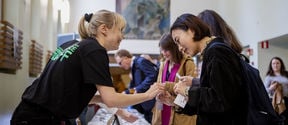Aalto-born Brain Stimulation Company Plans Initial Public Offering
Nexstim's invention makes use of a technique called Navigated Brain Stimulation (NBS), which offers two main advantages.
‘With other medical devices that use magnetic stimulation, the pulses are usually given without precise anatomic targeting, and these devices also cannot measure the brain's reaction. With Nexstim's devices and their use of three-dimensional structural images of the brain, it is possible to focus the stimulation accurately, on the order of millimetres, and thanks to the EEG recording, we immediately receive information about changes in the brain's electrical activity,’ says Professor Risto Ilmoniemi, one of the original developers of NBS.
Safer Operations
Among other benefits, NBS can improve the safety and predictability of outcomes in epilepsy and brain cancer surgery. Before, neurosurgeons had to cut open the skull so that they could locate the command centres that control the brain's motor pathways and so avoid damaging them during the operation. Now the same thing can be done safely and without hurry from outside the skull well before the operation begins.
These medical devices are already in use in all Finnish university hospitals, as well as in around twenty other countries from Russia to Germany and even as far as Japan. According to Professor Ilmoniemi, NBS based NBT (Navigated Brain Therapy) can also be used for treatment of brain disorders. The Rehabilitation Institute of Chicago, which has been repeatedly selected as the best rehabilitation hospital in the US, reported to have achieved good results in the spring when using NBT as a booster in the rehabilitation of stroke patients.
‘It is as though the stroke patient's healthy hemisphere dominates the sick half. By using focused magnetic stimulation, activity in the healthy hemisphere is suppressed so that the damaged side can recover,’ Ilmoniemi explains.
In Chicago the a group of patients were treated with a combination of NBT and normal occupational therapy three times a week over a period of six weeks. Over 80% of the patients made clinically significant improvements, compared to only 50% in the control group. If further studies go well, Nexstim could receive permission from the FDA to market the device for therapeutic use. This represents a significant opportunity both financially and for improving people's well-being. In the US alone, 795 000 people suffer from stroke each year, and it is estimated that around a third of these could benefit from Nexstim’s therapy. In Finland there are around 14 000 stroke victims every year.
A Wide Range of Specialists
Risto Ilmoniemi explained that he had founded Nexstim in 2000 in order to commercialise the research work that had been carried out in Helsinki University of Technology (now part of Aalto University) and the BioMag Laboratory at the Helsinki University Central Hospital. He also served as the company's managing director until the end of 2005.
‘We were selected for the pilot stage of the TEKES (Finnish Funding Agency for Innovation) Creating Business from Research programme, and later received venture capital from Sitra and from abroad,’ he mentioned while talking of the company's early years.
‘This work has required a wide variety of expertise: physicists, medical researchers, doctors, psychologists, electrical engineers and software developers. The user-friendly and intuitive interface is one of the device's best points. Safety is also extremely important: It must be made sure that, should human errors occur, the device will not put the patient at risk. Since my departure, the company has invested heavily in brain diagnostics and therapy–with excellent results,’ Ilmoniemi adds.
Further Information
Professor Risto Ilmoniemi
+358 50 5562964
[email protected]
Video: Rehabilitation Institute of Chicago - Navigated Brain Stimulation (youtube.com)
19 September Nexstim announced that it is planning an Initial Public Offering on NASDAQ OMX First North.
- Published:
- Updated:
Read more news

Robotics needs safe behavior patterns
Robotics and autonomous systems are developing rapidly. Algorithms that withstand disturbances and uncertainties in the system model and environment are critical for development.
Teaching a computer to type like a human
A new typing model simulates the typing process instead of just predicting wordsUnderstanding climate warming impacts on carbon release from the tundra
Tundras could transform from carbon sinks into a carbon source, exacerbating the effects of climate change